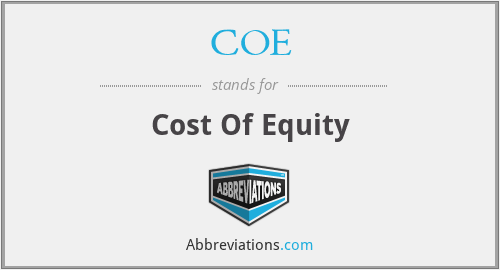What does COE mean in Accounting?
This page is about the meanings of the acronym/abbreviation/shorthand COE in the Business field in general and in the Accounting terminology in particular.
Submitted by paul8539 on May 9, 2008
Translation
Find a translation for Cost Of Equity in other languages:
Select another language:
- - Select -
- 简体中文 (Chinese - Simplified)
- 繁體中文 (Chinese - Traditional)
- Español (Spanish)
- Esperanto (Esperanto)
- 日本語 (Japanese)
- Português (Portuguese)
- Deutsch (German)
- العربية (Arabic)
- Français (French)
- Русский (Russian)
- ಕನ್ನಡ (Kannada)
- 한국어 (Korean)
- עברית (Hebrew)
- Gaeilge (Irish)
- Українська (Ukrainian)
- اردو (Urdu)
- Magyar (Hungarian)
- मानक हिन्दी (Hindi)
- Indonesia (Indonesian)
- Italiano (Italian)
- தமிழ் (Tamil)
- Türkçe (Turkish)
- తెలుగు (Telugu)
- ภาษาไทย (Thai)
- Tiếng Việt (Vietnamese)
- Čeština (Czech)
- Polski (Polish)
- Bahasa Indonesia (Indonesian)
- Românește (Romanian)
- Nederlands (Dutch)
- Ελληνικά (Greek)
- Latinum (Latin)
- Svenska (Swedish)
- Dansk (Danish)
- Suomi (Finnish)
- فارسی (Persian)
- ייִדיש (Yiddish)
- հայերեն (Armenian)
- Norsk (Norwegian)
- English (English)
Definition
What does COE mean?
- Cost of equity
- In finance, the cost of equity is the return (often expressed as a rate of return) a firm theoretically pays to its equity investors, i.e., shareholders, to compensate for the risk they undertake by investing their capital. Firms need to acquire capital from others to operate and grow. Individuals and organizations who are willing to provide their funds to others naturally desire to be rewarded. Just as landlords seek rents on their property, capital providers seek returns on their funds, which must be commensurate with the risk undertaken. Firms obtain capital from two kinds of sources: lenders and equity investors. From the perspective of capital providers, lenders seek to be rewarded with interest and equity investors seek dividends and/or appreciation in the value of their investment (capital gain). From a firm's perspective, they must pay for the capital it obtains from others, which is called its cost of capital. Such costs are separated into a firm's cost of debt and cost of equity and attributed to these two kinds of capital sources. While a firm's present cost of debt is relatively easy to determine from observation of interest rates in the capital markets, its current cost of equity is unobservable and must be estimated. Finance theory and practice offers various models for estimating a particular firm's cost of equity such as the capital asset pricing model, or CAPM. Another method is derived from the Gordon Model, which is a discounted cash flow model based on dividend returns and eventual capital return from the sale of the investment. Another simple method is the Bond Yield Plus Risk Premium (BYPRP), where a subjective risk premium is added to the firm's long-term debt interest rate. In addition, the cost of equity can be calculated by (proposed by Gebhardt et.al. (2001) - see Further Reading Section) using the discounted residual income model to estimate the market implied cost-of-capital. The paper shows that a firm’s implied cost-of-capital is a function of its industry membership, B/M ratio, forecasted long-term growth rate, and the dispersion in analyst earnings forecasts. Moreover, a firm's overall cost of capital, which consists of the two types of capital costs, can be estimated using the weighted average cost of capital model. According to finance theory, as a firm's risk increases/decreases, its cost of capital increases/decreases. This theory is linked to observation of human behavior and logic: capital providers expect reward for offering their funds to others. Such providers are usually rational and prudent preferring safety over risk. They naturally require an extra reward as an incentive to place their capital in a riskier investment instead of a safer one. If an investment's risk increases, capital providers demand higher returns or they will place their capital elsewhere. Knowing a firm's cost of capital is needed in order to make better decisions. Managers make capital budgeting decisions while capital providers make decisions about lending and investment. Such decisions can be made after quantitative analysis that typically uses a firm's cost of capital as a model input.
Popularity rank by frequency of use
How popular is COE among other acronyms?
COE#1#1336#12977
Embed
Citation
Use the citation below to add this abbreviation to your bibliography:
Style:MLAChicagoAPA
"COE." Abbreviations.com. STANDS4 LLC, 2024. Web. 31 Oct. 2024. <https://www.abbreviations.com/term/519103>.



Discuss this COE abbreviation with the community:
Report Comment
We're doing our best to make sure our content is useful, accurate and safe.
If by any chance you spot an inappropriate comment while navigating through our website please use this form to let us know, and we'll take care of it shortly.
Attachment
You need to be logged in to favorite.
Log In